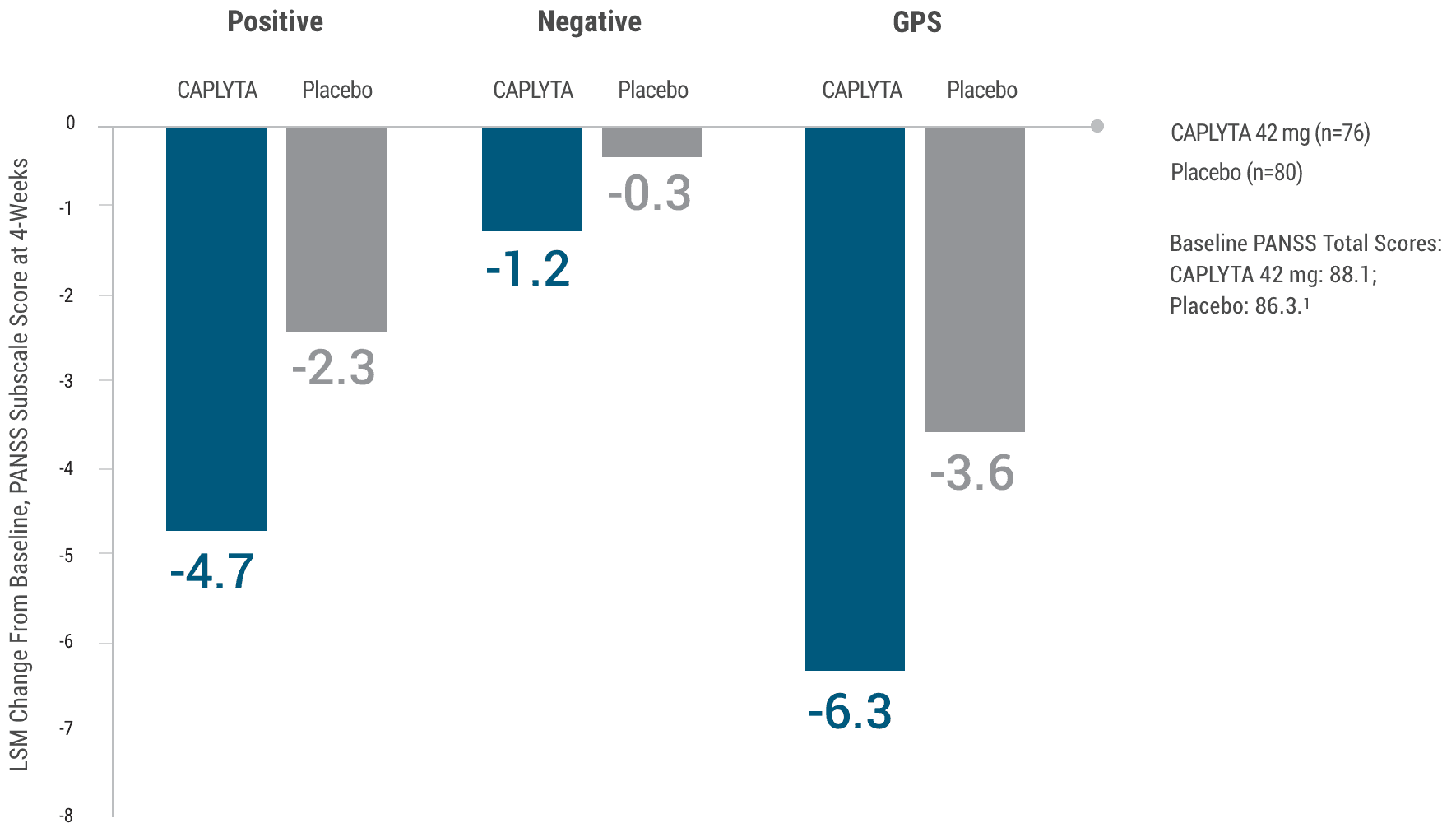
Efficacy
Mean scores in PANSS symptom domains were improved in patients treated with CAPLYTA2
Secondary endpoints: Change in PANSS symptom domains in Study 1
Study 1. Change from baseline in positive, negative, and general psychopathology subscale (GPS) symptoms of schizophrenia at 4 weeks2
Limitation: These secondary endpoints were not powered for statistical comparison and are descriptive only. Therefore, the results require cautious interpretation.

Limitation: These secondary endpoints were not powered for statistical comparison and are descriptive only. Therefore, the results require cautious interpretation.
A randomized, double-blind, placebo-controlled, multicenter, inpatient clinical trial that enrolled patients with an acute exacerbation of schizophrenia. The primary endpoint was change from baseline in the PANSS total score at Day 28 compared to placebo. Patients were screened for up to a 7-day drug-free period. All treatments were dosed as oral monotherapy once daily in the morning for 4 weeks.1,2
Study 1 randomized 335 patients to either CAPLYTA 42 mg, CAPLYTA 84 mg, active comparator, or placebo in a 1:1:1:1 fashion. Patients were generally moderately to markedly ill. Median age was 42 years (range 20 to 55 years). 17% were female, 19% were Caucasian, and 78% were African American. The treatment effect in the CAPLYTA 84 mg group (vs placebo) was not statistically significant.1,3
This graph depicts the change from baseline in positive, negative, and general psychopathology subscale symptoms of schizophrenia over 28 days for patients receiving CAPLYTA 42 mg or placebo.
Baseline PANSS total scores were 88.1 for CAPLYTA and 86.3 for placebo. At Day 28, patients on CAPLYTA saw a 4.7-point reduction in positive symptoms vs 2.3-point reduction for those on placebo. Patients on CAPLYTA saw a 1.2-point reduction in negative symptoms vs 0.3-point reduction for those on placebo. Patients on CAPLYTA saw a 6.3-point reduction in GPS symptoms vs 3.6-point reduction for those on placebo.
PANSS is a 30-item scale that measures the following symptoms6*:
- Delusions
- Hallucinations
- Conceptual disorganization
- Excitement
- Grandiosity
- Suspiciousness/persecution
- Hostility
- Blunted affect
- Emotional withdrawal
- Poor rapport
- Passive/apathetic social withdrawal
- Difficulty in abstract thinking
- Lack of spontaneity and flow of conversation
- Stereotyped thinking
- Somatic concern
- Anxiety
- Guilt feelings
- Tension
- Mannerisms and posturing
- Depression
- Motor retardation
- Uncooperativeness
- Unusual thought content
- Disorientation
- Poor attention
- Lack of judgment and insight
- Disturbance of volition
- Poor impulse control
- Preoccupation
- Active social avoidance
LSM=least squares mean.
Each item is rated by a clinician on a 7-point scale. A score of 1 indicates the absence of symptoms, and a score of 7 indicates extremely severe symptoms. The PANSS total score may range from 30 to 210, with higher scores reflecting greater overall symptom severity.1
